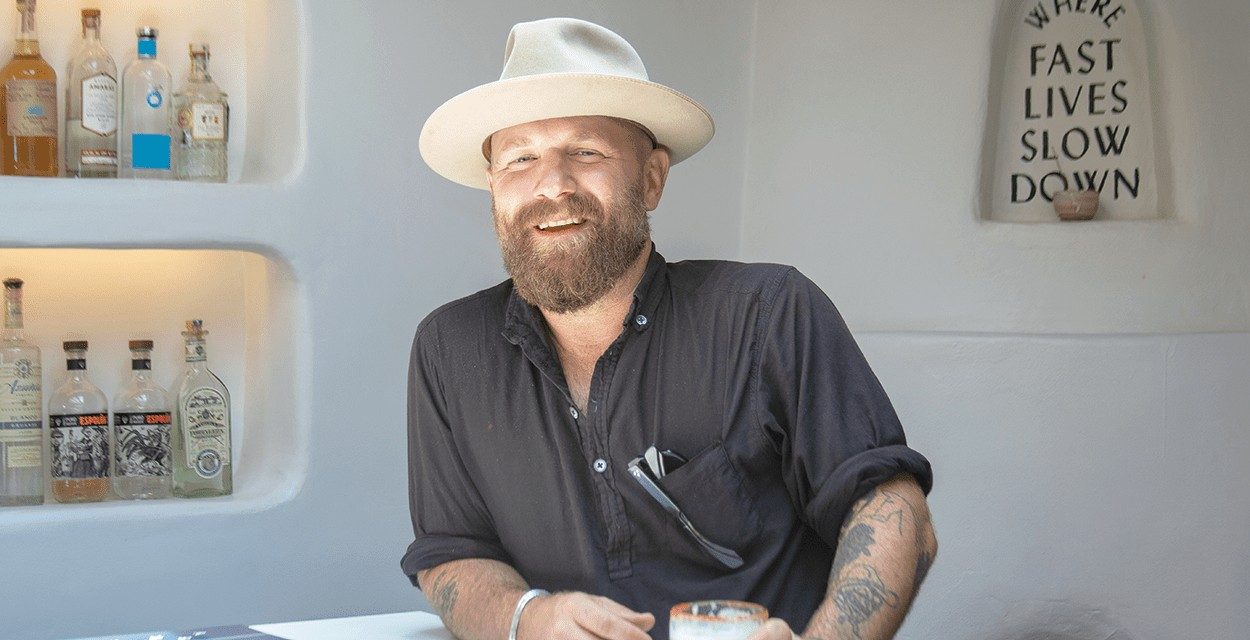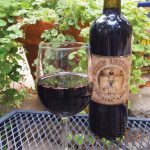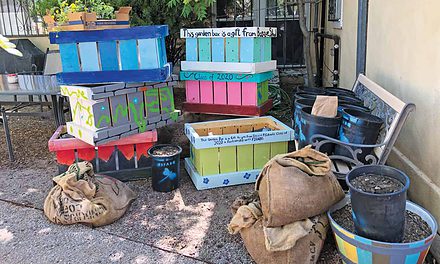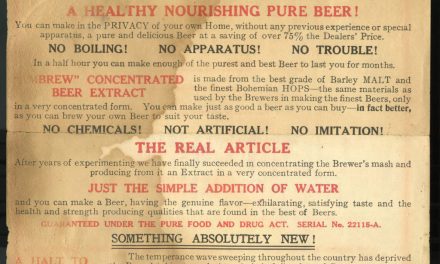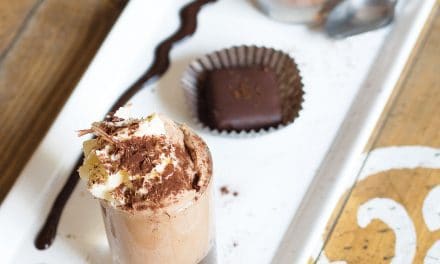The Style and Spirits of La Reina
By Candolin Cook · Photos by Stephanie Cameron

Left: Piña Picante and La Renia cocktails. Right: Jay Carroll, La Reina’s proprietor.
From Mabel Dodge Luhan and the Taos Society of Artists to Dennis Hopper and the counterculture movement, there exists a rich history of creative and influential outsiders finding inspiration in, and subsequently transforming, northern New Mexico. For better and for worse, generation after generation, artistic types continue to make pilgrimage to the region to experience the landscape that inspired Georgia O’Keeffe and to search quixotically for the Santa Fe of their imaginations. While baby boomers have dominated the capital for the last half century, millennials are beginning to put their own cultural mark on the city. With the opening of La Reina, a stylish mezcal-centered bar at the newly remodeled El Rey Court hotel, sojourners and locals alike have a watering hole for a new era.
La Reina contains its fair share of quintessential Santa Fe elements with its elegant Southwest style and quality libations. Yet, the Cerrillos Road establishment feels literally and figuratively miles apart from the typical Plaza scene—it’s hipper, fresher, younger. Painted inside a nicho in the corner of the bar, La Reina’s motto, “Where Fast Lives Slow Down,” sets the tone for its often jet-set clientele. On a recent rainy evening, I listened in as a fashionable couple from Austin chatted with their bartender about the most recent influx of young transplants to Santa Fe, and how so many of their friends across the country are making plans to visit the City Different. “It’s more under-the-radar, like Milwaukee, not overrun, like Marfa,” one explained, while sipping mezcal neat.
La Reina’s bar menu is largely a showcase for mezcal—currently one of America’s trendiest spirits. Sometimes referred to as tequila’s smokier cousin, mezcal, like tequila, is made from the agave plant. Though tequila is made exclusively from blue agave, mezcal is distilled from more than thirty varietals. Tequila must be produced in Jalisco, Mexico, or in designated neighboring areas, whereas mezcal is produced throughout Mexico, though it originally hails from Oaxaca. Roasting the agave hearts in underground pits before distillation creates mezcal’s distinctive smokey flavor. Once seen as a second-class spirit, mezcal’s popularity has soared in recent years thanks, in part, to millennials’ thirst for its complex flavors and appreciation of its small-batch production.
“We just wanted to feature mezcal because it’s what we love to drink,” says La Reina proprietor Jay Carroll. Jay and his business partner and wife Alison Carroll are recent, part-time, Santa Fe transplants by way of that other boho desert oasis, Joshua Tree. When a Texas-based company purchased the El Rey in 2016, they hired the Carrolls—who are accomplished designers, concept consultants, and owners of the popular olive oil company Wonder Valley—to reinvent the charming, though dated, five-acre, eighty-six room motor court into a boutique hotel destination more in step with the times. Over the course of the project, the Carrolls became partners in the business, and Jay says the renovation became as much restoration as reinvention: “We wanted to strip it down and let the bones sing. We wanted to marry history and [modernity] in this space.”

Chic El Rey Court room details.
Sitting at a long, rustic wood table in the impeccably decorated parlor between El Rey’s welcome desk and La Reina, Jay flips through a massive coffee table book on the career of Alexander Girard, who he credits as his biggest inspiration in designing the bar and hotel. “Some people have said the space looks very southern California, but many of the elements that are now considered California style actually originated here [in New Mexico] with people like Girard and O’Keeffe,” he explains. “It is so special here. In my opinion, the US has two cities with a truly unique fingerprint: New Orleans and Santa Fe.” To showcase a “sense of place” throughout the property, the Carrolls incorporated many pieces from Native American and local artists—woodworkers, weavers, painters, ceramicists. Especially as a newcomer, Jay tells me he tries to be cognizant of the pitfalls of utilizing Santa Fe style. “Our goal is to be celebratory and appropriate, not appropriative. And I welcome an open dialogue about that and hope that our intention comes through.”
The stark white paint had barely dried on the adobe walls before La Reina appeared in Vogue, and local and national “influencers” began to fill their social media feeds with shots of the property’s mid-century furniture, chic black and white patio, and attractive people holding attractive cocktails. (If you didn’t Instagram your visit to El Rey, were you even really there?) Despite the potential for pretension, La Reina is inviting with its casual vibe, ample seating, and warm candlelight from dozens of votives, which freely drip white wax over a centrally-located fireplace mantle. Jay pushes back against my initial impression that La Reina is primarily for the twenty-to-thirty-something scenester set, saying that that is not his intention nor experience: “We want everyone to feel welcome and our clientele has been very diverse.”
Jay says part of making the bar accessible is having a “democratic” price point. Unlike many upscale cocktail bars in town, La Reina’s signature drinks range from $9 to $12. Standouts include the La Reina, a slightly sweet and spicy blend of agua de jamaica, Casamigos Reposado, mezcal, and Ancho Reyes; and the SantaFamous—mezcal, pineapple, and a house verdita. My personal favorite is the refreshing West Texas creation, Ranch Water—tequila, Topo Chico, and lime, over ice. The bar does, however, stock some more expensive offerings, such as a mezcal de pechuga—made by suspending a raw chicken breast over the still to (allegedly) imbue a savory undertone—that runs $30 a shot. And if agave spirits are not your drink of choice, the bar is well-stocked with an assortment of other liquors, sake, draft beer, and wine.
The regulars I spoke with said La Reina is a welcome addition to Midtown and described the Carrolls as friendly, generous, and enthusiastic to be part of the community. To foster that community, every Thursday is Locals Night, where New Mexicans receive ten percent off their tab, and frequently there is a designated “La Reina of the week”—a local woman who is celebrated with a signature cocktail and party in her honor. The hotel’s pool is also open to locals who join the El Rey Swim Club, and there are plans in the works to host community events such as craft fairs, movie nights on the lawn, concerts, and pop-up dinners, along with more permanent food offerings. “Locals have really adopted us as a place to come and congregate and as a meeting ground for both travellers and locals,” says Jay.
The Carrolls believe El Rey can also act as a fresh introduction to the city. “If we’re doing our job right, El Rey and La Reina can be a passport to what I would want to experience as a visitor in Santa Fe,” says Jay. “When I was visiting in my twenties, I knew this was a special place, but it was hard to navigate. So much is geared toward Plaza culture and Canyon Road and an older generation. But there are so many incredible things beyond that. We’d like to facilitate an environment where locals [steer] visitors toward what they like to do. I think those interactions are important for both sides.” With the addition of new art and music spaces like Meow Wolf, an ever expanding and diversifying restaurant scene, and casual hangouts such as La Reina, Santa Fe is indeed becoming less Plaza-centric. “It feels like new things are happening all the time,” says Jay. “People have such a defined idea about what Santa Fe is or should be. I [was worried] the city would be resistant to change, but what I’ve discovered is that many people are optimistic about and welcoming to change, and any place is open to interpretation.”
Candolin Cook is a historian, writer, editor, and former co-editor of edible New Mexico. She recently received her doctorate in history from the University of New Mexico and is working on her first book.

